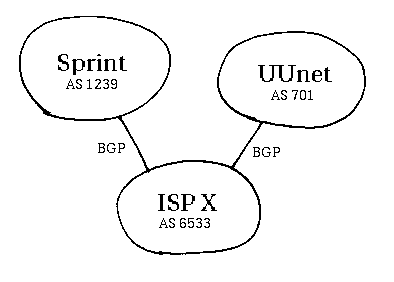BGP - Border Gateway Protocol
On the Internet, there are what are known as Interior Gateway Protocols (IGP) and Exterior Gateway Protocols (EGP). The difference is simplest to illustrate by example.
 Take ISP X, who has uplink connections to Sprint
and UUnet. ISP X has a complex network of routers and modem servers and
also has T1 and ISDN connections to customers of theirs. They use an Interior
routing protocol called OSPF to allow all of their networking equipment to
communicate amongst themselves to describe the network in great detail.
However, their uplinks, Sprint and UUnet, do not need or want to see that
level of detail, so ISP X communicates with Sprint and UUnet using an
Exterior routing protocol, BGP.
Take ISP X, who has uplink connections to Sprint
and UUnet. ISP X has a complex network of routers and modem servers and
also has T1 and ISDN connections to customers of theirs. They use an Interior
routing protocol called OSPF to allow all of their networking equipment to
communicate amongst themselves to describe the network in great detail.
However, their uplinks, Sprint and UUnet, do not need or want to see that
level of detail, so ISP X communicates with Sprint and UUnet using an
Exterior routing protocol, BGP.
In the above example, ISP X is an Autonomous System (AS). In other words, the admins of ISP X have control over networking equipment belonging to them. There is a clear delineation between ISP X's network and UUnet's network. Hence, ISP X and UUnet are two different Autonomous Systems.
Today, BGP4 is the only standard protocol for communicating between autonomous systems on the Internet. BGP4 is the fourth and current revision of the protocol. Anyone wanting to use BGP on the Internet must have an Autonomous System Number (ASN) assigned to them by ARIN. They currently charge money for this service.
Blah
- RFC 1771 A Border Gateway Protocol 4 (BGP-4)
- RFC 1772 Application of the Border Gateway Protocol in the Internet
- RFC 1773 Experience with the BGP-4 protocol
- RFC 1774 BGP-4 Protocol Analysis
- RFC 1265 BGP Protocol Analysis
- RFC 1266 Experience with the BGP Protocol
- RFC 1267 A Border Gateway Protocol 3 (BGP-3)
- RFC 1397 Default Route Advertisement in BGP2 and BGP3
- RFC 1403 BGP OSPF Interaction
- RFC 1655 BGP-4 Protocol Documentation Roadmap and Implementation Experience
- RFC 1657 Defintions of Managed Objects for the Fourth Version of the Border Gateway Protocol (BGP-4) using SMIv2
- RFC 1745 BGP4/IDRP for IP---OSPF Interaction